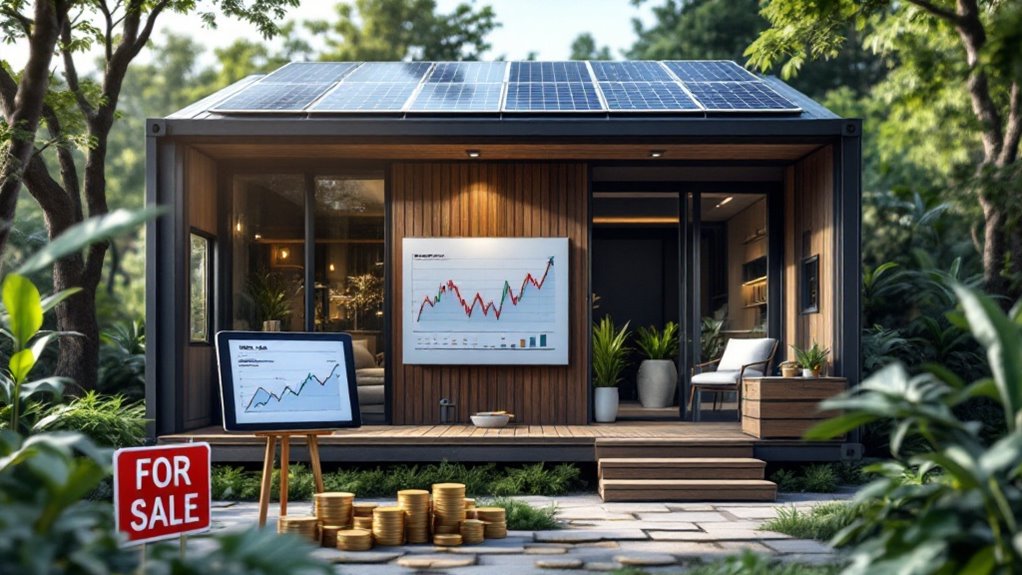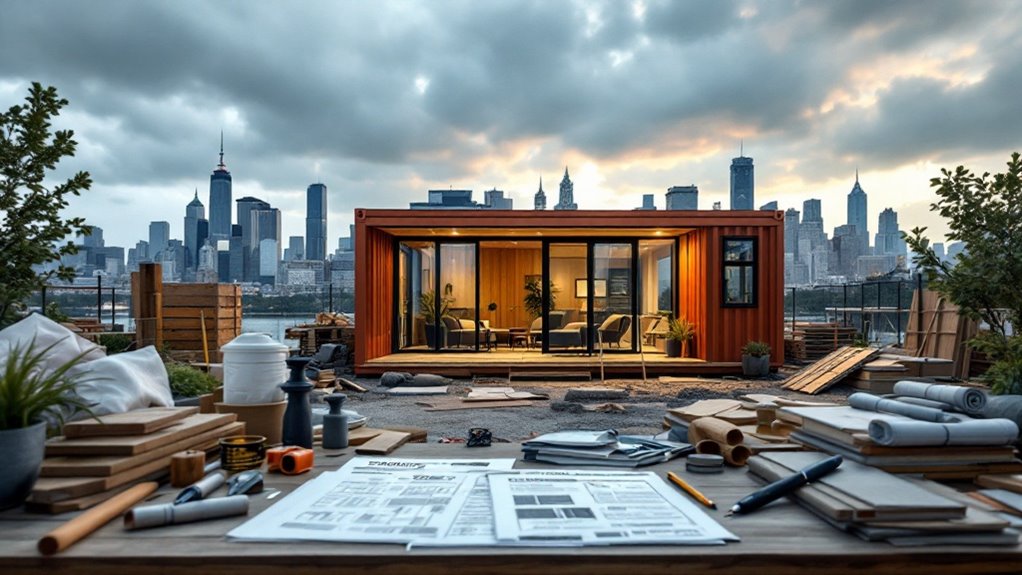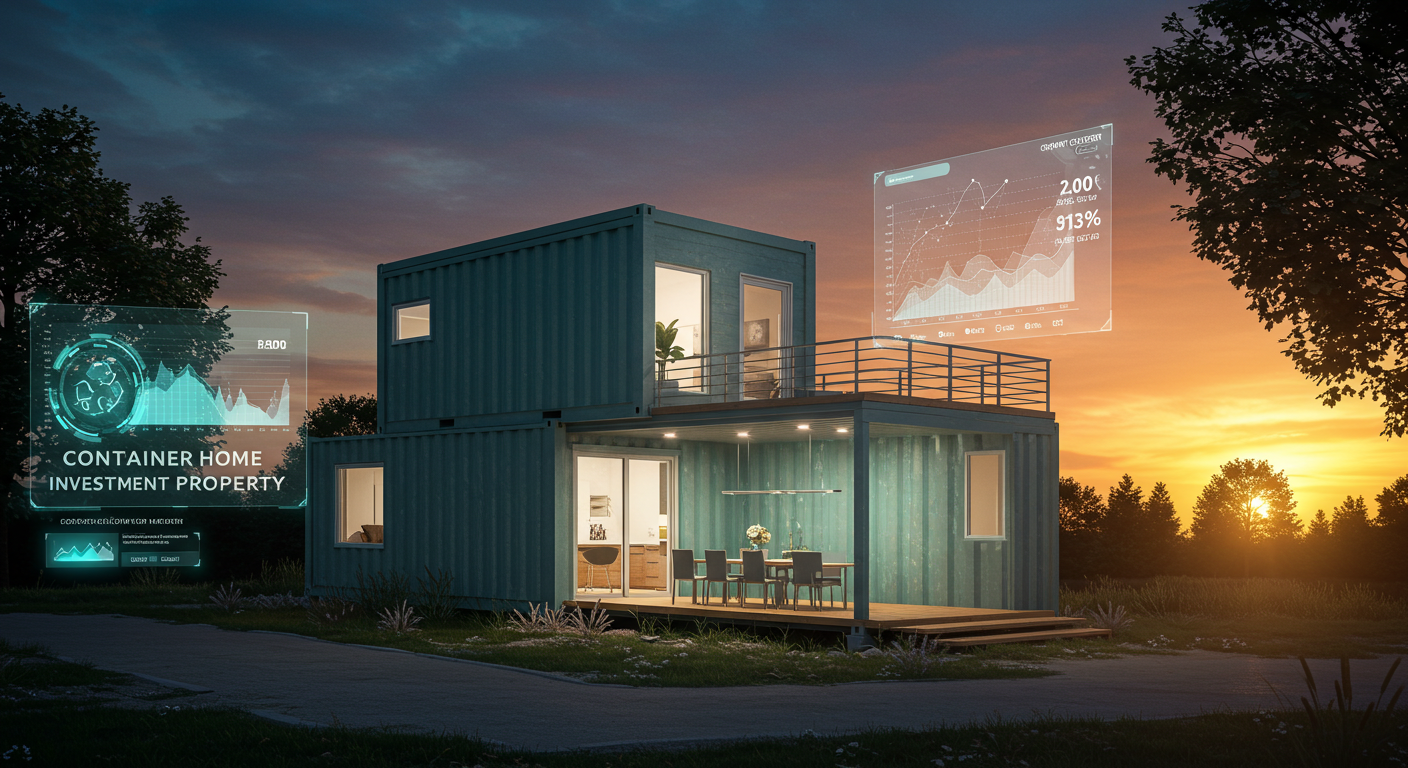A Container home investment property can be a smart, budget-friendly option, with construction costs 20-40% lower than traditional homes and resale values often exceeding 100%. The market is growing, projected to surpass $73 million by 2025, driven by eco-conscious buyers and short-term rental demand. However, you’ll face challenges like zoning restrictions, higher insurance costs, and limited financing options. Land and modification costs vary widely, so careful budgeting is key. Millennials and urbanites are drawn to their modern, sustainable appeal, but oversupply risks exist in some areas. Understanding these factors can help you make informed decisions and uncover deeper insights.
Key Takeaways
- Container homes offer 20-40% lower construction costs and high resale value, making them cost-effective investment properties.
- The short-term rental market for container homes generated $5.99 billion in 2021, highlighting strong income potential.
- Eco-friendly designs appeal to eco-conscious buyers and align with green real estate trends, increasing marketability.
- Financing challenges exist, but niche lenders and government-backed loans can provide solutions for unconventional properties.
- Zoning laws and building codes vary by location, requiring thorough research to ensure compliance and avoid delays.
Benefits of Container Home Investment Property
As the market for shipping container homes is projected to surpass $73 million by 2025, investing in these properties offers significant financial potential. Container homes offer a unique combination of affordability, durability, and versatility, making them an attractive option for investors. With construction costs often 20-40% lower than traditional homes, you can allocate more resources to customization or additional properties. Their steel structure guarantees longevity, reducing maintenance expenses and minimizing long-term risks.
The resale value of container homes can exceed 100%, providing a lucrative opportunity for flipping or selling. Their modular design allows for easy expansion or reconfiguration, enabling you to adapt to market trends or tenant demands. This flexibility is particularly valuable in the short-term rental market, which generated $5.99 billion in 2021. By leveraging platforms like Airbnb, you can capitalize on the growing demand for unique vacation stays, turning your container home into a steady income stream.
Container homes also appeal to eco-conscious buyers, as they repurpose materials and often incorporate sustainable features like solar panels or rainwater systems. This aligns with the increasing consumer preference for environmentally friendly housing, further boosting their marketability. However, it’s essential to research local zoning laws and building codes to mitigate regulatory risks. By understanding these factors, you can maximize the benefits container homes offer while minimizing potential challenges. Additionally, exploring creative financing strategies like seller financing or private money lending can help secure funding for your container home investment without relying on traditional loans.
Cost Analysis and Budgeting Tips
While container homes offer significant financial benefits, understanding the cost structure and budgeting effectively is key to maximizing your investment. A thorough cost analysis helps you identify both upfront and ongoing expenses, ensuring you avoid financial pitfalls. Start by breaking down costs into categories like land acquisition, construction, and maintenance. Land prices vary by location, so research local markets to find affordable yet desirable plots. Construction costs include container purchase, modifications, and labor, while maintenance covers repairs and upgrades over time.
To manage your budget, allocate funds for unexpected expenses, as custom designs or site-specific challenges can inflate costs. Use the table below to prioritize expenses and track your spending:
| Category | Estimated Cost Range | Budgeting Tips |
|---|---|---|
| Land Acquisition | $10,000 – $100,000+ | Research zoning laws and utility access. |
| Container Purchase | $1,500 – $5,000 per unit | Buy used containers to save on initial costs. |
| Modifications | $10,000 – $50,000 | Prioritize insulation and structural integrity. |
| Labor | $20,000 – $100,000 | Hire experienced contractors to avoid costly mistakes. |
| Maintenance | $1,000 – $5,000 annually | Set aside 5-10% of your budget for upkeep. |
Financing Options for Container Homes

Securing financing for a container home often requires exploring non-traditional options, as many lenders hesitate to approve mortgages for unconventional properties. Traditional financing options for container homes, such as standard mortgages, can be challenging to obtain due to the unique nature of these structures. Instead, you may need to evaluate alternative financing options for container homes, such as personal loans or construction loans, which offer more flexibility for non-traditional builds.
Some lenders specialize in financing unconventional properties, including shipping container homes, and can provide tailored solutions to meet your needs. These niche lenders understand the market and are more likely to approve loans for container home projects. Additionally, government-backed loans may be available in certain jurisdictions, offering lower interest rates or favorable terms for eco-friendly or affordable housing initiatives.
Hard money loans are another viable option, especially if you need quick access to capital. These asset-based loans often provide pre-approval amounts up to $5 million, making them suitable for larger container home projects. However, they typically come with higher interest rates and shorter repayment terms, so you’ll need to weigh the risks carefully. For those with limited funds, exploring down payment assistance programs can help reduce upfront costs and make container home investments more accessible.
Regardless of the financing options for container homes you choose, thorough financial planning is critical. Budget for upfront costs like land acquisition, utility connections, and modifications to guarantee your project stays on track. By understanding the risks and opportunities in the market, you can make informed decisions to secure the right financing for your container home investment.
Market Trends and Demand Insights
The container home market is rapidly expanding, with projections estimating it will surpass $73 million by 2025, fueled by the growing need for affordable housing solutions. As urbanization accelerates and property costs rise, container housing is gaining traction as a cost-effective and innovative alternative. Millennials, in particular, are driving demand, drawn to the flexibility and modern design of these homes. Additionally, the eco-friendly appeal of repurposed shipping containers aligns with the increasing preference for sustainable living, making them a viable option for green building certifications.
Short-term rental platforms like Airbnb, which generated $5.99 billion in 2021, highlight the investment potential of container homes as unique vacation rentals. Their compact, customizable designs cater to travelers seeking distinctive experiences, creating opportunities for steady rental income. However, you should remain cautious of market dynamics. While demand is strong, the growing popularity of container housing could lead to oversupply in certain regions, potentially impacting resale value and rental yields. Understanding local market conditions is crucial to identifying areas with high demand and avoiding oversaturated markets.
To capitalize on this trend, you’ll need to identify areas with high demand for affordable housing or vacation rentals. Urban centers and tourist hotspots are prime targets, but you must also assess local competition and zoning regulations. By staying informed about market trends and balancing enthusiasm with risk awareness, you can position yourself to benefit from the expanding container housing market while mitigating potential challenges.
Challenges and Regulatory Considerations

You’ll face zoning and permitting hurdles, as local regulations often lag behind the growing popularity of container homes, creating delays or outright restrictions. Building code compliance issues, particularly around insulation and structural modifications, can escalate costs and complicate project timelines. Additionally, securing insurance and financing may prove challenging, as lenders and insurers often view container homes as higher-risk investments compared to traditional housing.
Zoning and Permitting Hurdles
While container homes offer a cost-effective and sustainable housing solution, maneuvering zoning and permitting hurdles can be a significant challenge. Zoning regulations for shipping container homes vary widely by location, and you’ll often find that obtaining the necessary permits isn’t straightforward. Some municipalities have updated their building codes to accommodate container homes, but many still impose restrictions that can delay your project. You may need to hire professionals to navigate complex local regulations, which can increase upfront costs and extend timelines. In certain areas, zoning laws classify container homes as temporary structures, limiting their use for long-term residency and potentially affecting your investment’s viability. Additionally, community acceptance plays a role in permitting, as local resistance to unconventional housing can further complicate approvals. To mitigate these risks, research local zoning regulations thoroughly before purchasing land or starting construction. Understanding these barriers early can save you time and money, ensuring your container home project aligns with both market demands and regulatory requirements.
Building Code Compliance Issues
Since building codes for shipping container homes differ widely by location, you’ll need to navigate a patchwork of regulations to guarantee compliance. Many municipalities impose strict zoning laws that may limit or outright prohibit the use of shipping containers as permanent residences, creating legal and logistical challenges. You’ll often face a complex permitting process, requiring multiple inspections and approvals from local authorities, which can delay your project timeline. Structural modifications, such as reinforcing flat roofs or ensuring proper insulation, may also be mandated, adding to your construction costs. Staying informed about evolving building codes is critical, as some regions are beginning to adapt regulations to accommodate alternative housing solutions like shipping container homes. This shift could open up new opportunities, but for now, you must meticulously research local requirements to mitigate risks. Non-compliance can lead to fines, project halts, or even demolition orders, making it essential to prioritize adherence to all applicable codes. By understanding these regulatory hurdles, you can better plan your investment and avoid costly setbacks.
Insurance and Financing Challenges
Because shipping container homes are often classified as unconventional properties, securing financing and insurance can present significant hurdles. Traditional lenders may hesitate to offer mortgages due to the unique nature of these homes, pushing you toward alternative financing options like personal or construction loans. However, even these alternatives can be limited, as not all lenders specialize in unconventional properties, complicating your acquisition process. Insurance costs may also be higher compared to traditional homes, as insurers often view container homes as higher risk due to their unique structure and potential market stigma. Additionally, local zoning regulations and building codes can further complicate matters, with some jurisdictions not recognizing container homes as permissible housing, impacting your ability to secure permits. The unpredictable resale value of container homes, influenced by location and market perception, adds another layer of risk, potentially affecting your return on investment. When maneuvering through these challenges, it’s essential to research lenders and insurers familiar with unconventional properties and guarantee compliance with local regulations to mitigate risks. Consider exploring private lenders who offer flexible loan terms and competitive interest rates, which can be particularly advantageous for unconventional property investments.
Environmental and Sustainability Advantages
You’ll find that container homes leverage eco-friendly building materials, primarily repurposed shipping containers, which reduce waste and align with sustainable housing trends. Their construction process typically generates a lower carbon footprint than traditional homes, as they require fewer raw materials and less energy-intensive labor. This efficiency not only appeals to environmentally conscious buyers but also positions container homes as a competitive option in the growing green real estate market.
Eco-Friendly Building Materials
Shipping container homes offer a compelling solution for eco-conscious investors by leveraging repurposed materials that reduce waste and align with sustainable building practices. By using recycled shipping containers, you’re diverting these steel structures from landfills, which minimizes environmental impact and supports circular economy principles. This approach not only reduces the demand for new construction materials but also lowers the carbon footprint associated with traditional building methods. Additionally, shipping containers are inherently durable, requiring fewer resources for maintenance over time, which enhances their long-term sustainability.
Energy-efficient designs are another key advantage. You can integrate features like high-performance insulation, energy-efficient windows, and renewable energy systems, such as solar panels, to further reduce environmental impact. These upgrades not only align with green building certifications like LEED but also appeal to eco-conscious buyers and tenants, boosting your property’s marketability. By prioritizing eco-friendly building materials, you’re not just investing in a property—you’re contributing to a sustainable future while mitigating risks associated with resource-intensive construction. This makes shipping container homes a smart, forward-thinking choice for environmentally aware investors. To streamline financial management and ensure compliance, consider using real estate-specific bookkeeping tools like Baselane or Stessa for accurate tracking and reporting.
Reduced Carbon Footprint
When investing in shipping container homes, you’re directly contributing to a reduced carbon footprint by repurposing existing materials and minimizing resource-intensive construction processes. Container homes utilize recycled shipping containers, which considerably cut down on waste and the need for new resources, aligning with sustainable development goals. Compared to traditional building methods, the construction of container homes generates a lower carbon footprint, making them an environmentally conscious choice. Many container homes are designed with energy-efficient features, such as solar panels, further reducing reliance on fossil fuels and enhancing sustainability. These homes often qualify for green building certifications like LEED, which recognize their adherence to energy efficiency and sustainability standards. Additionally, the smaller physical footprint of container homes promotes efficient land use, reducing urban sprawl and encouraging eco-friendly living practices. By choosing container homes, you’re not only investing in a property but also supporting a market trend that prioritizes environmental responsibility and long-term sustainability. This approach mitigates risks associated with resource depletion and aligns with growing consumer demand for eco-conscious housing solutions. For those looking to expand their real estate portfolio, understanding creative financing strategies from books like *Wealth Without Cash* can further enhance your ability to invest sustainably.
Conclusion
Investing in container homes aligns with market trends favoring sustainability and affordability. You’ll find costs 20-40% lower than traditional builds, but zoning and financing hurdles remain. Demand is rising, with eco-conscious buyers driving growth. Yet, risks like regulatory delays or material shortages persist. By balancing innovation with caution, you can tap into this niche while minimizing exposure. The future’s green, and container homes might just be your ticket to a profitable, eco-friendly portfolio.




